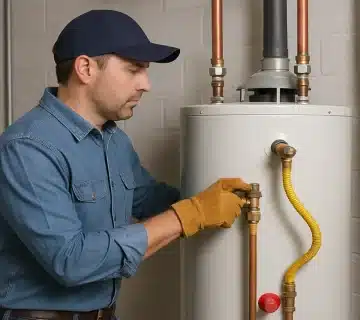Your water heater is one of the most important appliances in your home. It quietly provides hot water for showers, laundry, and dishes. But sometimes, things go wrong — and you suddenly find yourself with no hot water. The good news? In many cases, all you need to do is learn how to reset water heater safely
Knowing how to reset water heater properly can save you from unnecessary repair bills and get your hot water running again quickly. This guide explains why your water heater may need a reset, when to use the reset button, and the safest way to do it step by step.
Why Do You a Water Heater Need Resetting?
Most modern electric water heaters are built with safety features. The reset button — sometimes called the “high-limit switch” — trips whenever water temperature inside the tank becomes dangerously high. This protects your system from overheating and prevents accidents.
Some common reasons your heater might need a reset include:
- A faulty thermostat not shutting off heating elements.
- Power surges or electrical issues.
- Sediment buildup causing overheating.
- Heating elements malfunctioning.
If your water heater keeps tripping frequently, it’s a warning sign. Resetting it is a temporary fix, but repeated problems mean you should call a professional.
How to Reset Water Heater: 5 Proven Easy Steps
Follow these steps carefully to reset your electric water heater safely:
- Turn Off Power
- Locate your circuit breaker panel.
- Switch off the breaker labeled “Water Heater” to avoid electrical shock.
- Access the Reset Button
- Remove the access panel on the front of your water heater.
- You may need to remove insulation or a safety cover.
- Press the Red Reset Button
- Look for a red button near the thermostat.
- Firmly press it until you feel a click.
- Reattach Covers
- Replace insulation and secure the access panel.
- Make sure everything is back in place before restoring power.
- Restore Power & Test
- Turn the breaker back on.
- Wait about an hour, then test your hot water.
For a visual walkthrough, see this detailed guide on resetting an electric water heater.
Mistakes to Avoid
When learning how to reset water heater, homeowners often make these mistakes:
- Forgetting to turn off the breaker before pressing reset.
- Resetting repeatedly without solving the root cause.
- Ignoring signs of leaks or electrical burning smells.
- Touching exposed wires inside the panel.
Avoiding these mistakes ensures your safety and protects your heater from further damage.
When to Call a Professional
If your water heater keeps tripping the reset button every day, resetting won’t solve the underlying issue. Common repairs may include:
- Replacing faulty thermostats.
- Fixing or replacing heating elements.
- Flushing sediment buildup.
- Repairing electrical connections.
At this point, a licensed plumber or technician should inspect the unit.
FAQs: How to Reset Water Heater
Q: Where is the reset button located?
It’s usually a red button behind the access panel near the upper thermostat.
Q: How long does it take for hot water to return after a reset?
Typically about one hour for an average 40–50 gallon tank.
Q: Can I reset a gas water heater the same way?
Gas units don’t use a reset button. Instead, you relight the pilot light following manufacturer instructions.
Q: Is it safe to press the reset button often?
No. If it trips more than once or twice, it signals a bigger issue. Contact a professional.
Final Thoughts
Once you know how to reset water heater correctly, you’ll feel more confident handling sudden hot water problems at home. By following the correct steps — turning off power, pressing the reset button, and restoring power — you can often restore hot water without needing immediate repairs.
Still, keep in mind that frequent resets indicate a deeper problem. Regular maintenance, flushing your tank, and professional inspections are the best ways to prevent issues and keep your water heater running smoothly.





